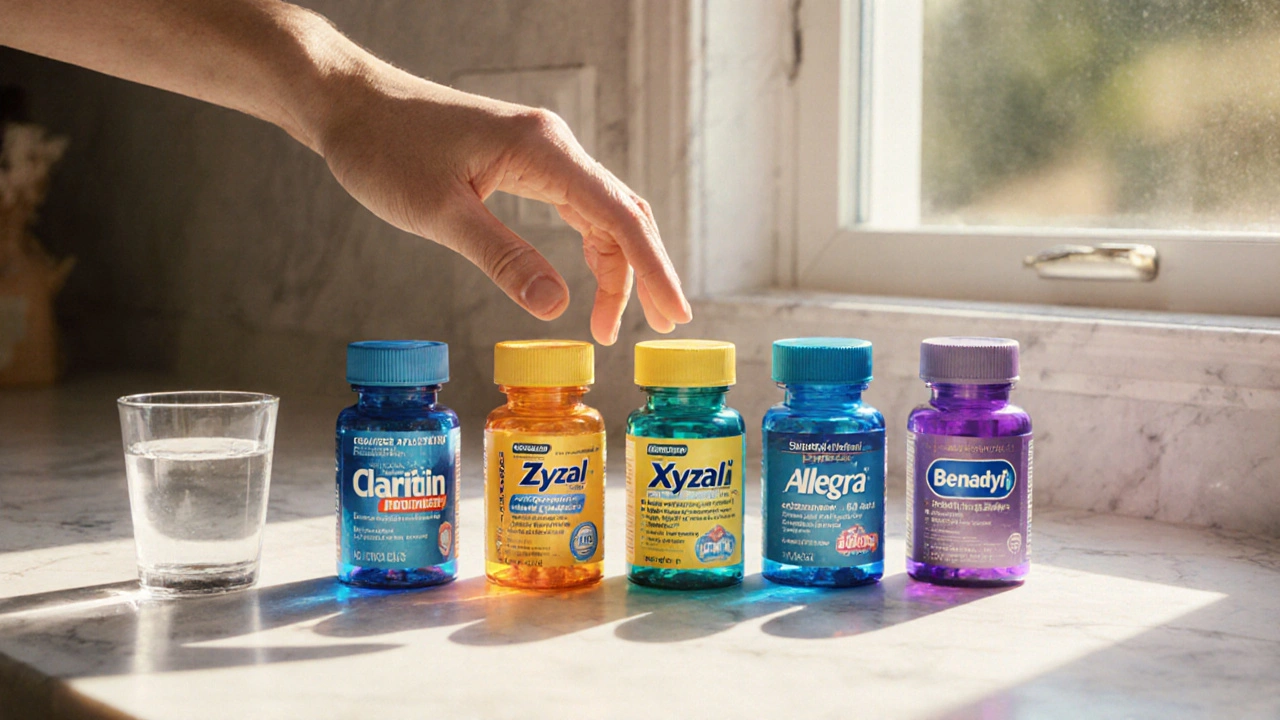Antihistamine Selector
| Medication | Onset Time | Duration | Sedation Risk | Avg. Price (1 month) |
|---|---|---|---|---|
| Claritin (Loratadine) | 60 mins | 24 hrs | Low | $10-$12 |
| Zyrtec (Cetirizine) | 30-60 mins | 24 hrs | Moderate | $8-$10 |
| Allegra (Fexofenadine) | 15-30 mins | 12-24 hrs | Very Low | $9-$11 |
| Benadryl (Diphenhydramine) | 15-30 mins | 4-6 hrs | High | $5-$8 |
| Xyzal (Levocetirizine) | 30-60 mins | 24 hrs | Moderate | $15-$18 |
Key Takeaways
- Claritin (loratadine) offers 24‑hour, non‑sedating relief but can be pricier than generic options.
- Zyrtec (cetirizine) works slightly faster and may cause mild drowsiness in sensitive users.
- Allegra (fexofenadine) is the best choice for people who need zero sedation and prefer a fast onset.
- Benadryl (diphenhydramine) provides strong relief for acute reactions but is highly sedating and short‑acting.
- Xyzal (levocetirizine) sits between Zyrtec and Claritin in efficacy and sedation, often recommended for chronic indoor allergies.
When it comes to seasonal allergies, Claritin is a non‑sedating antihistamine whose active ingredient is loratadine. It’s one of the most recognizable names on pharmacy shelves, but dozens of alternatives promise similar or even better outcomes. This antihistamine comparison helps you decide which product fits your lifestyle.
What is Claritin (Loratadine)?
Loratadine belongs to the second‑generation antihistamine class, meaning it blocks histamine receptors without crossing the blood‑brain barrier in large amounts. The result? Allergy symptoms‑like sneezing, itchy eyes, and runny nose‑are tamed without the sleepy feeling that older antihistamines cause. A single 10mg tablet provides up to 24‑hour relief, and it’s safe for most adults and children over six years old.
Top Alternatives at a Glance
Below are the most common OTC antihistamines you’ll see in the aisle:
- Zyrtec - active ingredient cetirizine, works in 1 hour, may cause mild drowsiness.
- Allegra - active ingredient fexofenadine, fast 30‑minute onset, virtually non‑sedating.
- Benadryl - active ingredient diphenhydramine, 30‑minute relief, strong sedation, best for occasional use.
- Xyzal - active ingredient levocetirizine, 1‑hour onset, slightly more sedating than Claritin but less than Benadryl.

How They Stack Up: Efficacy & Onset
Clinical studies consistently rank second‑generation antihistamines as equally effective at reducing histamine‑driven symptoms. The main differentiators are how quickly they kick in and how long they last.
| Antihistamine | Onset (minutes) | Duration (hours) | Peak Effect | Typical Dose |
|---|---|---|---|---|
| Claritin | 60 | 24 | 12‑18 | 10mg once daily |
| Zyrtec | 30‑60 | 24 | 8‑12 | 10mg once daily |
| Allegra | 15‑30 | 12‑24 | 6‑10 | 180mg once daily |
| Benadryl | 15‑30 | 4‑6 | 2‑4 | 25‑50mg every 4‑6h |
| Xyzal | 30‑60 | 24 | 8‑12 | 5mg once daily |
For most users, Claritin, Zyrtec, and Xyzal provide comparable 24‑hour coverage, while Allegra may edge out on speed. Benadryl shines only when you need rapid relief for an unexpected reaction, such as a bee sting, but its short life span means you’ll have to re‑dose.
Side‑Effect Profile & Sedation
Second‑generation antihistamines were engineered to stay out of the brain, reducing the classic "sleepy" side‑effect. However, individual chemistry can still cause mild drowsiness.
- Claritin: very low sedation risk (≈2% of users report any drowsiness).
- Zyrtec: slightly higher sedation (≈6‑10%) but still tolerable for most adults.
- Allegra: essentially non‑sedating (≈1%).
- Benadryl: strong sedation (≈50‑70%) and anticholinergic effects like dry mouth.
- Xyzal: modest sedation (≈8‑12%).
If you need to drive or operate machinery, Allegra or Claritin are the safest bets. For nighttime relief, Benadryl can double as a sleep aid, but be aware of the next‑day grogginess.
Cost, Availability & Age Suitability
Price is often the deal‑breaker for long‑term daily use. Below is a quick snapshot of average U.S. retail prices (2025 data) for a one‑month supply:
- Claritin (brand): $25‑$30; generic loratadine: $10‑$12.
- Zyrtec (brand): $22‑$28; generic cetirizine: $8‑$10.
- Allegra (brand): $20‑$26; generic fexofenadine: $9‑$11.
- Benadryl (brand & generic): $5‑$8.
- Xyzal (brand): $30‑$35; generic levocetirizine: $15‑$18.
All of these products are widely available in pharmacies, grocery stores, and online platforms. Age restrictions vary:
- Claritin: approved for ages 6+ (children 2‑5mg daily available as syrup).
- Zyrtec: approved for ages 2+.
- Allegra: approved for ages 12+; a pediatric formulation (30mg) exists for ages 6‑11.
- Benadryl: safe for ages 6+, but dizziness is more common in kids.
- Xyzal: approved for ages 6+.
Choosing the Right Antihistamine for You
Think of the decision as matching three variables: how fast you need relief, how much sedation you can tolerate, and your budget.
- Fast onset, minimal drowsiness: Allegra wins.
- All‑day coverage, zero sedation: Claritin or generic loratadine is a solid, affordable pick.
- Occasional intense reaction (e.g., hives, insect bite): Reach for Benadryl, but stay away from the wheel.
- Moderate sedation is okay, prefer a single daily pill: Zyrtec or Xyzal-choose Zyrtec if you’re price‑sensitive, Xyzal if you want a slightly stronger antihistamine.
Every body reacts differently, so a short trial period (5‑7days) of the chosen product is wise. Keep track of symptom control, any drowsy episodes, and cost. If you find yourself reaching for another dose before 24hours are up, a switch to a faster‑acting alternative may be in order.

Frequently Asked Questions
Can I take Claritin and Zyrtec together?
No. Both drugs block the same H1 histamine receptors, so combining them offers no extra benefit and raises the risk of side‑effects. Choose one based on your priority-speed or sedation.
Is Claritin safe for pregnancy?
Loratadine is classified as Pregnancy Category B, meaning animal studies have not shown risk, but human data are limited. Always consult your obstetrician before starting any medication.
Why does Benadryl make me sleepy?
Benadryl is a first‑generation antihistamine that crosses the blood‑brain barrier, directly affecting the central nervous system and causing drowsiness.
Can I use Allegra if I have hypertension?
Fexofenadine does not usually raise blood pressure and is considered safe for most hypertensive patients, but always verify with your doctor.
How long does it take for Claritin to start working?
Most people feel relief within 60minutes, with full effect achieved by 2‑3hours.

Oh great, another wiki‑style showdown-because we all needed a spreadsheet for our sneezes.
Look, I’m not here to write a dissertation, but the hype around Allegra’s speed feels overblown. If you need something that kicks in in 15 minutes, go ahead and pop it. For most of us, the 24‑hour coverage of Claritin is plenty. The price gap isn’t huge, so don’t let “fast” blind you. Bottom line: drama aside, pick what fits your schedule.
It is worth noting that the pharmaceutical giants have quietly aligned their research agendas to favor second‑generation antihistamines, thereby marginalizing older compounds that might be more effective for certain subpopulations. While the data presented appears comprehensive, one must consider the possibility of undisclosed sponsorship influencing the comparative outcomes. The omission of any discussion regarding potential off‑label uses raises further suspicion. In an era where data transparency is often compromised, vigilance remains essential. Consequently, consumers should scrutinize the underlying motives behind such “neutral” guides.
Honestly, the whole compairson feels like a marketing pamphlet dressed up as science. The table shows benadryl as cheap, but forgets to mention the hidden cost of grogginess the next day. Also, the onset times for claritin are overstated – many folks report relief taking longer than an hour. I could go on, but i guess that's enough contrarian spice for now.
While I appreciate your candid observations, it is important to balance critique with constructive guidance. Acknowledging the limitations of each antihistamine allows readers to make informed decisions without feeling swayed by anecdotal bias. For instance, highlighting the pharmacokinetic profiles alongside cost considerations can paint a more holistic picture. Moreover, emphasizing proper dosing schedules reinforces safe usage. Let us aim to support one another in navigating these therapeutic options responsibly.
Upon meticulous examination of the comparative data presented, one must first address the orthographic consistency of the tabular headings, as uniformity in terminology is paramount for scholarly precision. The designation of “Onset Time” should, for the sake of scientific rigor, be expressed in standardized units, preferably minutes, rather than an amalgam of minute ranges. In addition, the inclusion of pharmacodynamic descriptors, such as receptor affinity constants, would substantiate the efficacy claims articulated herein. The narrative also neglects to reference the pivotal meta‑analyses that have evaluated antihistamine performance across heterogeneous populations, an omission that diminishes the report’s comprehensiveness. Moreover, the discussion of sedation risk lacks quantifiable metrics, such as the proportion of subjects experiencing somnolence in controlled trials, which would enhance the evidentiary foundation. It is also advisable to delineate the metabolic pathways, for example cytochrome P450 involvement, given their relevance to drug‑drug interaction potential. The cost analysis, while helpful, should be adjusted for inflation and regional pricing variations to afford greater applicability. Furthermore, the absence of a disclaimer regarding contraindications in specific comorbid conditions, such as hepatic impairment, represents a notable gap. The presentation of age‑specific dosing regimens would further tailor the guidance to pediatric and geriatric cohorts. The authors might also consider integrating patient‑reported outcome measures to capture real‑world effectiveness. The inclusion of a brief summary table contrasting the pharmacological classes would aid visual learners. Additionally, adherence to the Chicago Manual of Style for citation formatting would elevate the manuscript’s academic credibility. It is commendable that the guide attempts to empower consumers, yet the incorporation of these refinements would substantially augment its utility. In conclusion, while the document serves as a functional overview, the aforementioned enhancements are indispensable for attaining a benchmark of scholarly excellence.
Thank you for the thorough editorial suggestions; your attention to detail is truly impressive. I’ll incorporate the recommended clarifications to ensure the guide meets the highest academic standards. Your feedback exemplifies the collaborative spirit that advances our collective knowledge.
Claritin’s low drowsiness 👍, decent price 💰 – solid all‑day choice.
Indeed, the concise summary captures the essence; however, one might argue that brevity occasionally sacrifices nuance; consequently, readers should remain vigilant about the underlying complexities; after all, a single sentence cannot encapsulate the full pharmacologic profile.
In contemplating the intricate tapestry of antihistaminic therapy, one discovers that the decision matrix extends beyond merely pharmacokinetic parameters, weaving together personal lifestyle rhythms, tolerance thresholds, and even the subtle psychosocial narratives that accompany chronic allergic afflictions. The juxtaposition of rapid onset agents such as fexofenadine against the steadfast, once‑daily reliability of loratadine invites a meditation on the value we assign to immediacy versus consistency, a dichotomy that mirrors broader existential considerations of instant gratification versus sustained equilibrium. Moreover, the economic dimension-though seemingly peripheral-exerts a palpable influence on adherence, as the cumulative cost over months can either reinforce or erode the therapeutic alliance between patient and medication. It is therefore incumbent upon the discerning individual to engage in a reflective appraisal, perhaps maintaining a symptom‑tracking journal, thereby translating subjective experience into objective data that can illuminate the optimal pharmacologic pathway. Ultimately, the pursuit of allergy relief becomes a microcosm of the human quest for balance, wherein the harmonization of efficacy, safety, and personal preference coalesces into a personalized regimen that respects both physiological exigencies and the broader context of one’s daily existence.
yo man, this whole antihistamine thing feels like a secret club, ya know? they hide the real scoop in fine print while we just grab the cheap pills. i swear there's a plot to keep us guessing about side effects. it's dramaa, but i cant help feeling we're being played.
From a clinical decision‑support perspective, the pharmacoeconomic model favors loratadine when factoring in adherence‑boosting once‑daily dosing and low CNS penetration, thereby optimizing the therapeutic index across heterogeneous allergy phenotypes.